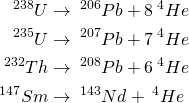The (U-Th)/He thermochronology method is based on the radioactive production of 4He from four primary decay schemes:

4He systematics have been determined for a variety of accessory minerals which preferentially incorporate U and Th, including rutile, titanite, goethite, monazite, and olivine, however (U-Th)/He thermochronology is most commonly applied using the minerals apatite and zircon. 4He diffuses rapidly through solids at even moderate temperatures, and thus the closure temperature of the (U-Th)/He thermochronometer is among the lowest routinely applied, at around 65°C in apatite and 180°C in zircon. Thus, a (U-Th)/He age records the time at which a given rock (or its mineral constituents) cooled below that temperature.
Given typical geothermal gradients in the Earth (~25°C/km), the (U-Th)/He thermochronometer is sensitive to temperatures within the upper few kilometers of the Earth’s surface. This aspect of the (U-Th)/He system makes it valuable for deciphering near-surface thermal histories, and thus applicable to a range of problems in geomorphology, landscape evolution, neotectonics, and climate-tectonic applications that are generally more difficult to approach using thermochronometric techniques with higher closure temperatures.
The University of Michigan Thermochronology Lab is able to measure U, Th, Sm, and He on a range of minerals and we always on the lookout for new collaborations and interesting applications of the (U-Th)/He thermochronometer. Please be in touch with lab PIs Nathan Niemi (naniemi@umich.edu) Marin Clark (marinkc@umich.edu) or lab manager Amanda Maslyn (afcarey@umich.edu) for additional information.

